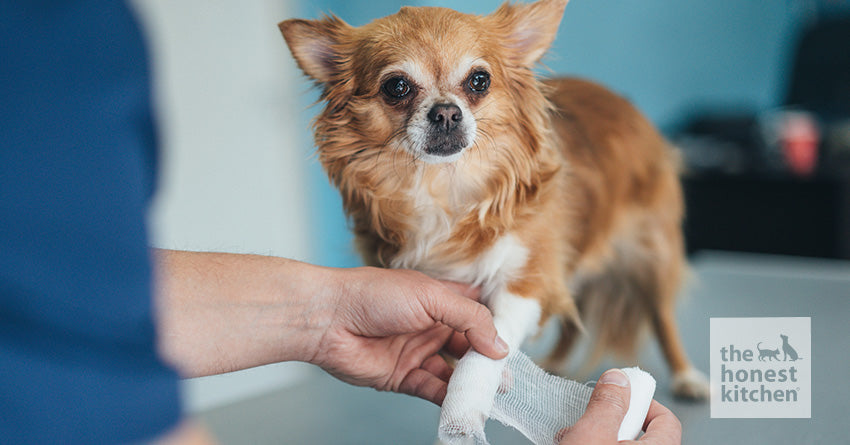Do you ever feel a twinge in your back as you stand up from the couch or wake up with sore knees after going for a jog the day before? Joint pain is a common issue for many of us — and it affects our dogs, too.
Your dog might be experiencing joint pain if you notice them limping, losing muscle mass, or not being as active. Dog joint pain can have a range of causes and may require surgery depending on the underlying cause. In many cases, however, you can successfully help manage and prevent joint pain at home through methods like diet, supplements, and hot and cold therapy.
While you should always consult with your veterinarian before diagnosing or treating your pet for joint pain, the guidance in this article will help you better manage it at home.
Signs and Symptoms of Dog Joint Pain
While every dog presents with pain differently, some of the most common joint pain symptoms in dogs include:
- Limping
- Reduced activity or reduced interest in exercise
- Stiffness
- Licking or biting the affected joint
- Loss of muscle mass
- Irritability
- Loss of appetite
- Lethargy and depression
It’s important to keep in mind that joint pain in dogs can have multiple causes. Make sure you consult your veterinarian so they can help figure out the underlying cause of your dog’s joint pain. Your vet will also provide the appropriate treatment options.
Dog Breeds Most Likely To Experience Joint Pain
Some dog breeds are more likely to have joint pain than others. The #1 risk factor for joint pain in dogs is obesity. This is due to the added strain on the joints caused by excess weight.
The #2 factor is genetics. Dogs that are predisposed to obesity or genetically predisposed to joint abnormalities will likely experience more joint pain than others.
What’s more, osteoarthritis is a degenerative process. This means the older a dog is, the more likely they are to demonstrate symptoms of arthritis.
Large and small dogs alike can be predisposed to arthritis. Large breeds that commonly experience joint pain and arthritis include:
- Labrador Retrievers
- German Shepherds
- Newfoundlands
- Rottweilers
- Golden Retrievers
- Burmese Mountain Dogs
- Mastiffs
- Sheepdogs
- Beagles
- Old English bulldogs
- Dachshunds
- Boston terriers
- Maltese
- Jack Russells
- Yorkshire Terriers
This doesn’t mean that other breeds won’t have joint pain. Any dog can develop arthritis or simply have pain in their joints. But if you own one of these specific dog breeds, you’ll need to watch closely for signs of pain or arthritis.
Causes and Types of Joint Pain in Dogs
Joint pain has multiple causes. Your dog’s pain could stem from arthritis, degenerative issues, or a developmental condition.
Arthritis
Arthritis is a common cause of joint pain in dogs. Where does arthritis come from? Immune-mediated osteoarthritis (IMPA) is a type of arthritis related to the immune system that can be initiated by Lyme disease, certain medications, or certain vaccinations. Infectious organisms, including tick-borne illnesses such as Lyme, can lead to arthritis.
Some dogs develop arthritis after experiencing trauma to the joint. Others have degenerative arthritis. In this case, the joint ages, the cartilage thins, and the joint fluid becomes watery.
Joint incongruity can also come into play. This happens in dogs that are predisposed to dysplasias. Their joints don’t fit together correctly, causing pain.
Keep in mind that approximately 50% of dogs with arthritis show no symptoms. Joints are healthiest when active — motion is lotion. Since joints have little to no vascularity (veins), they rely on motion to provide nutrients.
Degenerative Joint Problems
A degenerative joint issue is any problem with a dog’s joints that gets worse over time. Typically, the term “degenerative joint disease” refers to arthritis or osteoarthritis. The articular cartilage becomes brittle over time. This might occur because of surgery, injury, or another joint disease and is more likely to occur in obese dogs.
Developmental Issues and Conditions
Developmental joint problems occur when part of a dog’s body does not develop correctly. Dysplasia is a good example. Hip or elbow dysplasia is abnormal bone growth or cartilage development. It’s most common in large breeds such as retrievers.
Surgical Treatments For Dog Joint Pain
In extreme cases, dogs may need surgery to address the root cause of their joint pain, including:
Arthroscopy
An arthroscopy is a procedure that uses a camera to explore the hip, elbow, or knee joint. During the surgery, the veterinarian can see a video feed from inside the joint and can then also perform surgery if needed. Arthroscopy can treat conditions like osteoarthritis or elbow dysplasia.
Hip Replacement
Similar to a hip replacement in humans, hip replacement in dogs replaces a damaged hip joint with an artificial one. Severe arthritis caused by hip dysplasia may call for a total hip replacement. This surgery often makes a huge difference in the dog’s pain levels and ability to function.
Elbow Surgery
Elbow surgery can treat conditions like elbow dysplasia and osteoarthritis. This surgery removes damaged tissues to help with pain and might also realign the elbow joint in severe cases.
Osteochondritis Dissecans (OCD) Surgery
Osteochondritis dissecans (OCD) is a condition where diseased cartilage comes apart from the bone. Surgery removes this piece of cartilage.
Femoral Head and Neck Ostectomy (FHO)
A femoral head and neck ostectomy (FHO) may be recommended if your dog has severe hip pain due to conditions like osteoarthritis, hip dysplasia, or complications from a total hip replacement. This surgery is usually used as a last resort.
How Dog Owners Can Prevent Dog Joint Pain
The best way to help prevent joint pain in your dog is to keep them fit and thin. Their body condition score (think of this as the animal version of BMI) should be within the ideal range. You should be able to slightly see your dog’s ribs without touching them. Their waist and abdominal tuck should also be easy to see.

Help your dog stay trim by keeping them active. Take daily walks if possible and encourage games of fetch. If it’s cold outside or you don’t have a backyard, create indoor games like tug-of-war, hide-and-seek, puzzle games, or teach them a new trick.
How To Relieve and Manage Your Dog’s Joint Pain
Outside of surgery, you can help your dog improve joint pain in many other ways — however, always consult your veterinarian before taking steps to manage your dog’s joint pain at home.
It’s also essential to take a comprehensive approach. While weight management is important, you should use several treatment methods (such as diet combined with exercise) rather than just one.
Food Supplements
Dietary supplements can be a great add-on to your dog’s diet if they need a nutritional boost.
Here at The Honest Kitchen, we make pet food that spans the best of both worlds — it provides the essential nutrients and fuel your dog needs, with a taste that they love. Our new Hip & Joint Functional Pour Over is specifically designed to support hip and joint health.
The chicken bone broth mixture includes extra EPA and DHA, two omega-3 fatty acids. DHA is linked to brain, nervous system, and eye function, and EPA is best known for its potential anti-inflammatory properties. Because dogs can’t produce significant quantities of EPA or DHA naturally, it’s important that they supplement production through their diet.
Weight Management
Since obesity is one of the top contributors to joint pain in dogs, keeping your pup at a healthy weight is extremely helpful in preventing pain. More weight puts more strain on the joints. Less weight, then, is easier for the joints to handle.
Ask your vet about the healthiest weight range for your dog’s breed, age, and gender. They can also guide you on the best type and amount of food and give exercise recommendations to help your dog stay trim.
Nutritious Diet
A diet that’s rich in antioxidants, omega-3 fatty acids, and glucosamine can help support joint health and reduce inflammation. Since omega-3 fatty acids are commonly found in fish, we recommend our fish diet if your dog’s food needs more omega-3s. Our Dehydrated Grain Free Fish (including dehydrated white fish, salmon, and other human grade ingredients) is a great option.
Your dog’s diet should also be low carb (carbs are inflammatory), moderate to high in protein, and moderate to low in fat. Your goal is to promote lean body mass. Fat has a systemic inflammatory effect, so when dogs carry extra fat, they’re more likely to develop arthritis.
Low-Impact Strength Training and Activity
Strength training is another method of helping with dog joint pain. However, all activity for dogs with arthritis (or dogs at risk of arthritis) needs to be low impact — exercises that don’t put as much pressure on the joints.
Leash walking and swimming are two great options to try. Do your best to make sure your dog doesn’t do anything high-impact, like running or jumping. You can also help your dog avoid hard surfaces like tile, hardwood, or concrete and opt for more forgiving, shock-absorbing surfaces instead (like carpet or grass).
Hot and Cold Therapy
Experts recommend using cold therapy (such as crushed ice wrapped in a towel) for acute injuries, post-surgery swelling, and inflammatory conditions. Heat (a hot water bottle wrapped in a towel) is best for chronic conditions, osteoarthritis, and muscle soreness.
In addition to hot and cold therapy, you can also implement other non-pharmaceutical treatments with your dog. Your vet may recommend:
- Acupuncture
- Laser therapy
- Massage
- Physical rehabilitation
- Passive range of motion
If you’re interested in performing range-of-motion exercises, it’s best to work with a certified veterinary chiropractor rather than attempting these movements at home.
Pharmaceutical Treatments
Pharmaceutical treatments are another option to help soothe your dog’s joint pain. Consider asking your vet about any of the following:
- NSAIDS: NSAIDS are the gold standard and come with the highest level of evidence.
- Amantadine: Amantadine is related to ketamine, but is an oral drug. Recent research suggests it’s highly effective in regulating pain and has little to no side effects.
- Endocannabinoids: CBD receptors in the body allow CBD to effectively manage pain. CBDA is anti-inflammatory and great for treating arthritis.
- Gabapentin: Anticonvulsant Gabapentin is commonly used and has few side effects. It also has a highly sedating effect in older dogs.
Oral supplements are another common way to help support canine joint issues like arthritis:
- Omega-3 fatty acids
- CBD/CBDA (ensure you find a dog-friendly option)
- Green-lipped mussel
- Eggshell membrane
- Boswelia serrata
- Antioxidants (red marine algae, alpha-lipoic acid, beta carotene, vitamin E, green team, SAMe)
- Deer antler velvet
- UC II (undenatured collagen)
- HA (hyaluronic acid)
- Turmeric/curcumin
- Yucca
- Devil’s claw
Support Your Dog's Joint Pain With Functional Pour Overs From The Honest Kitchen
Joint pain can impact your dog’s quality of life as they struggle to run, jump, or play without pain. Luckily, there are many things pet parents can do at home to decrease inflammation and help relieve signs of joint pain, such as helping your dog with weight loss, administering joint supplements, and improving their diet.
An easy place to start is with The Honest Kitchen’s functional pour overs, which include the best ingredients and supplements to support canine joint health. Try our Hip & Joint Pour Over on top of your dog’s daily food to give them a nutrient-dense boost that supports their joints.
*Health Disclaimer: This post is educational in nature and doesn’t constitute health advice. Please consult your pet's veterinarian or other healthcare professional for specific guidance on this topic.

